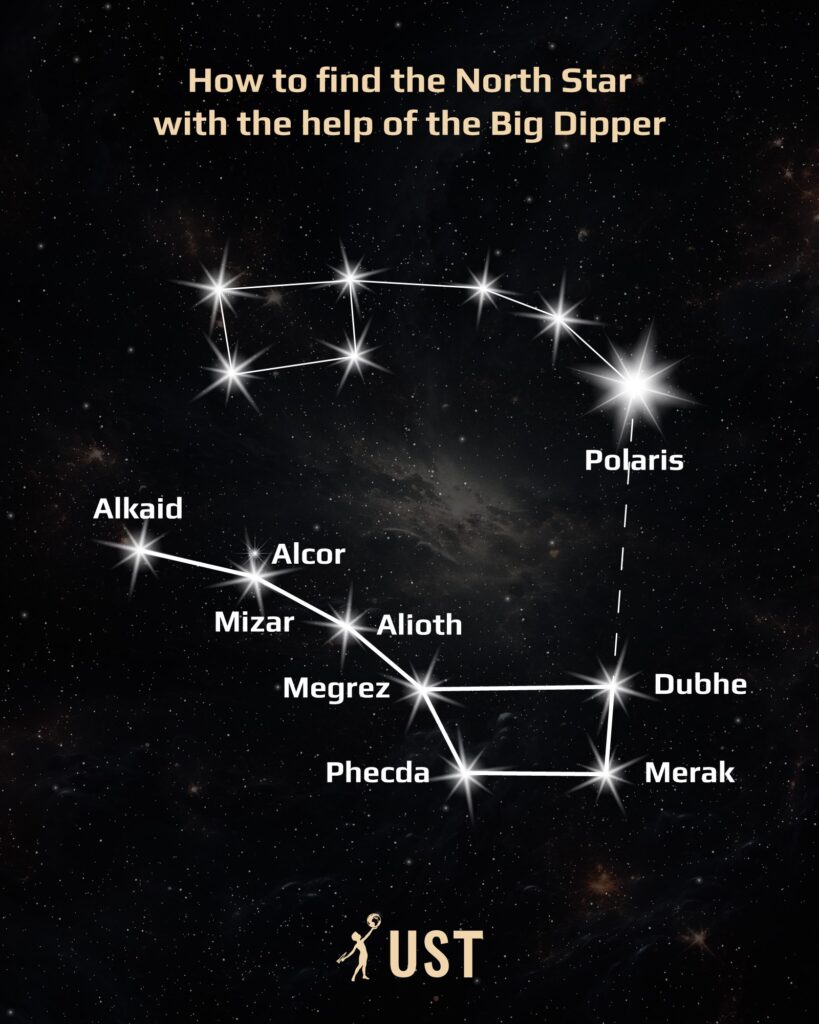Among all the constellations, people most often recall the zodiacal ones. Apparently, many people believe in the influence of the heavenly bodies on human destiny. But in fact, the sky is not limited to them alone. Today we will talk about Ursa Major (“Greater Bear”), which is also called the Big Dipper.

1. Why is the constellation Ursa Major so named?
If you are in Ukraine, you can see the constellation Ursa Major every night — of course, if there are no clouds. It is easy to recognize by the large figure formed by its brightest stars, resembling a dipper with a handle. It is also called the Big Dipper.
However, astronomy uses a name that comes to us from Ancient Greece. This constellation is present in the catalog of the starry sky of Claudius Ptolemaeus. According to legend, the King Lycaon’s daughter Callisto gave birth to a son, Arcas, from the god Zeus. However, the jealous wife of the last one, Hera, turned her into a bear.
Arcas did not recognize his mother and tried to kill her. To prevent this, Zeus took the Callisto bear to the sky and turned it into a constellation. According to legend, he pulled her by the tail to do this, so the constellation has a long “dipper handle” — the tail of the bear.
2. How many stars are in the Big Dipper?
In fact, the constellation Ursa Major contains thousands and even millions of stars, because it is just a dedicated section of the sky that includes absolutely all the luminaries located in this direction. However, we can see only 70 of them with the naked eye.
At the same time, even most of these 70 people rarely notice and know only those that form the dipper. If you ask an ordinary person how many stars are included in the Ursa Major, he will most likely answer that there are seven, meaning Dubhe, Merak, Phecda, Megrez, Alioth, Mizar and Alkaid. However, if you look closely at Mizar (the middle star of “Dipper”), you can see another tiny star nearby, which is called Alcor — “Horseman”.
3. How to find the Ursa Minor with the help of the Ursa Major?
Ursa Major in our latitudes can always be seen in the sky due to the fact that it belongs to the circumpolar constellations of the Northern Hemisphere. In our country, it never goes below the horizon, and this is very convenient because, with its help, you can always find the North Star, which means the direction to the north.
You need to find the Dipper and its two extreme stars: Dubhe and Merak. The last one is at the “bottom” of the Dipper. Connecting it mentally with the Dubhe (“edge” of the Dipper) and continuing this segment along a straight line another 5.5 times, we will “stumble” on the North Star.
4. Which stars in the constellation Ursa Major are the closest?
Like any constellation, Ursa Major consists of stars that are mostly not physically connected to each other in any way and are not even located next to each other. In addition, their distance is constantly changing. Therefore, the question of the distance to it is actually meaningless. However, it includes three stars within 16 light-years of us: Lalande 21185, Groombridge 1618 and Gliese 418. However, they are all red dwarfs, so none of them can be seen with the naked eye. But at least two of them have planets orbiting them.

5. What galaxies are there in Ursa Major?
Ursa Major is not just about stars. There are other astronomical objects in this constellation. For example, the Owl Nebula M97 (a planetary nebula) is visible within its limits, and, unfortunately, it is also not bright enough for the naked eye. Once upon a time, this nebula was formed from a star similar to our Sun. Hydrogen thermonuclear fuel ran out in its bowels, and it turned into a red giant, which soon shed its gas shells.
There are also a number of famous galaxies in Ursa Major: M81, M82 (the Cigar Galaxy), M101 (the Pinwheel Galaxy), which recently flared up with one of the brightest supernovae in the last decade, M109 and Zwicky 18 — a dwarf galaxy consisting almost exclusively of hydrogen and helium formed at the time of the Big Bang.
Follow us on Twitter to get the most interesting space news in time
https://twitter.com/ust_magazine


